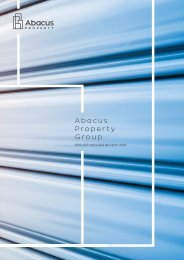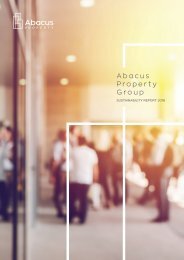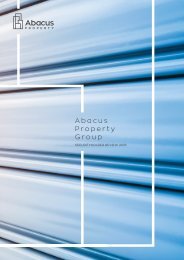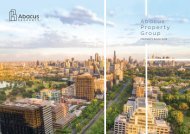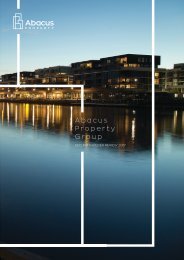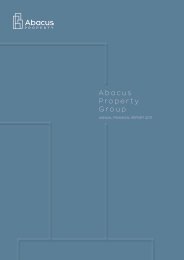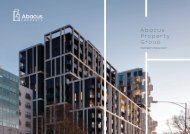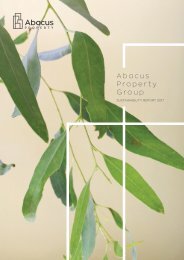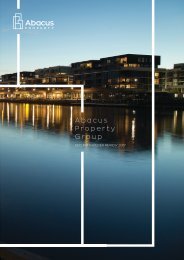Abacus Property Group – Annual Financial Report 2018
Create successful ePaper yourself
Turn your PDF publications into a flip-book with our unique Google optimized e-Paper software.
DIRECTORS’ REPORT<br />
30 June <strong>2018</strong><br />
ABACUS PROPERTY GROUP<br />
OPERATING AND FINANCIAL REVIEW (continued)<br />
GROUP RESULTS SUMMARY (continued)<br />
The underlying profit reflects the statutory profit as adjusted to present a figure which reflects the Directors’<br />
assessment of the result for the ongoing business activities of <strong>Abacus</strong>, in accordance with the AICD / Finsia<br />
principles for reporting underlying profit. The consolidated profits / (losses) which belong to the securityholders of<br />
<strong>Abacus</strong> Hospitality Fund and <strong>Abacus</strong> Wodonga Land Fund are excluded as these profits cannot and do not form<br />
part of the distributable income of <strong>Abacus</strong>. The calculation of underlying profit excludes items such as unrealised<br />
fair value gains / losses on investment properties, unrealised provision gains / losses, adjustments arising from<br />
the effect of revaluing assets / liabilities carried at fair value (such as derivatives, financial instruments and<br />
investments), the consolidated profits / (losses) of managed funds which do not form part of the assessable or<br />
distributable profits of <strong>Abacus</strong> and other adjustments in the determination of underlying profit including<br />
transactions that occur infrequently and those that are outside the scope of <strong>Abacus</strong>’ core ongoing business<br />
activities. Underlying profit is the basis on which distributions are determined.<br />
The reconciliation between the <strong>Group</strong>’s statutory profit excluding non-controlling interests and <strong>Abacus</strong>’ underlying<br />
profit is below. This reconciliation and the underlying profit have not been reviewed or audited by the <strong>Group</strong>’s<br />
auditor.<br />
<strong>2018</strong> 2017<br />
Consolidated statutory net profit after tax attributable to members of the <strong>Group</strong> 243,709 285,097<br />
add back: Consolidated profits relating to the managed funds (these profits are excluded as the<br />
profits of the managed funds cannot and do not form part of the assessable and distributable income<br />
of <strong>Abacus</strong>) 1,169 (27,165)<br />
Net profit attributable to <strong>Abacus</strong> securityholders 244,878 257,932<br />
$'000<br />
$'000<br />
Certain significant items:<br />
Net change in fair value of investment properties held at balance date (60,724) (74,773)<br />
Net change in fair value of investments and financial instruments held at balance date 6,363 10,677<br />
Net change in fair value of derivatives (730) (4,317)<br />
Net change in fair value of property, plant and equipment and investment properties included in equity (4,635) (718)<br />
accounted investments<br />
Net tax benefit on significant items (1,831) (1,999)<br />
Underlying profit attributable to <strong>Abacus</strong> securityholders 183,321 186,802<br />
<strong>2018</strong> 2017<br />
Basic earnings per security (cents) 42.18 49.91<br />
Basic underlying earnings per security^ (cents) 31.73 32.71<br />
Distribution per security^ (cents - including proposed distribution) 18.00 17.50<br />
Weighted average securities on issue (million) 577.8 571.2<br />
^<strong>Abacus</strong><br />
During the 12 months to 30 June <strong>2018</strong> the real estate markets across Australia continued to see historically low<br />
interest rates as the RBA maintained the cash rate at 1.5% while the forward guidance is for an ultimate increase<br />
in the cash rate. This outlook continues to support Australia as an appealing real estate market to global capital<br />
seeking high quality assets with attractive yields in a global low yield environment. These conditions saw further<br />
cap rate compression across the majority of sectors of the market from traditional asset classes lead by the<br />
highest quality of office, retail and industrial through to alternative asset classes of self-storage, healthcare<br />
facilities, manufactured homes and hotels/pubs. A strong leasing market, particularly in Sydney and Melbourne<br />
office markets and general industrial markets during the year also contributed to the attractiveness of real estate<br />
assets to domestic and global investors. Increased merger and acquisition activity in the listed real estate<br />
markets has also intensified valuations and interest in direct real estate markets. The strength of the market<br />
continues despite a backdrop of economic uncertainty and disparate economic activity throughout Australian<br />
States.<br />
5



